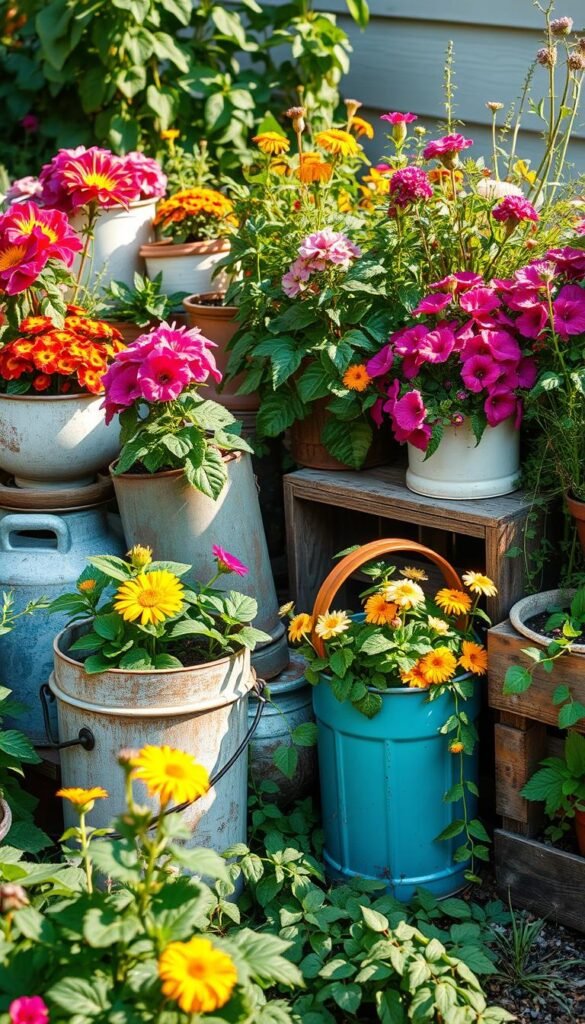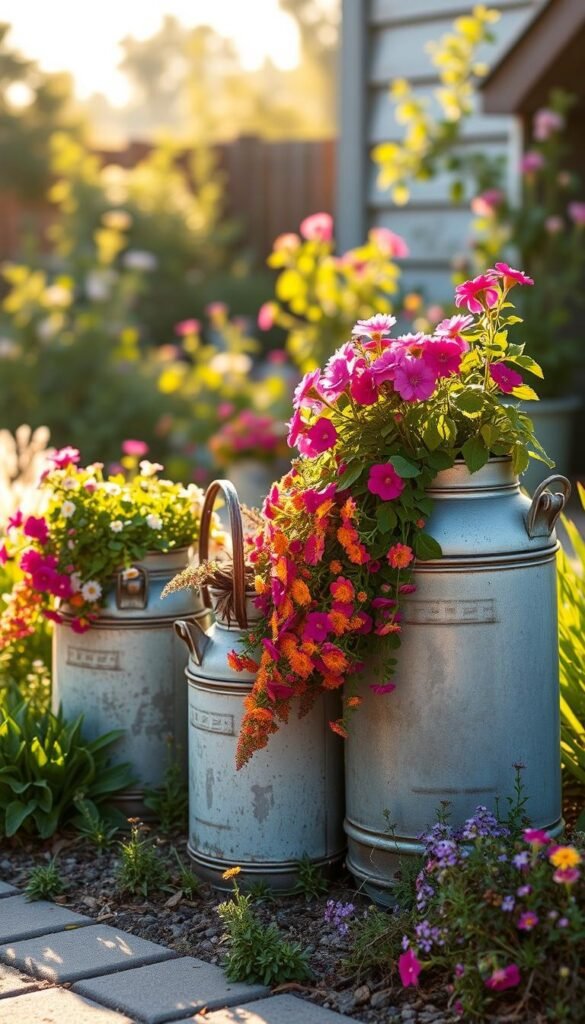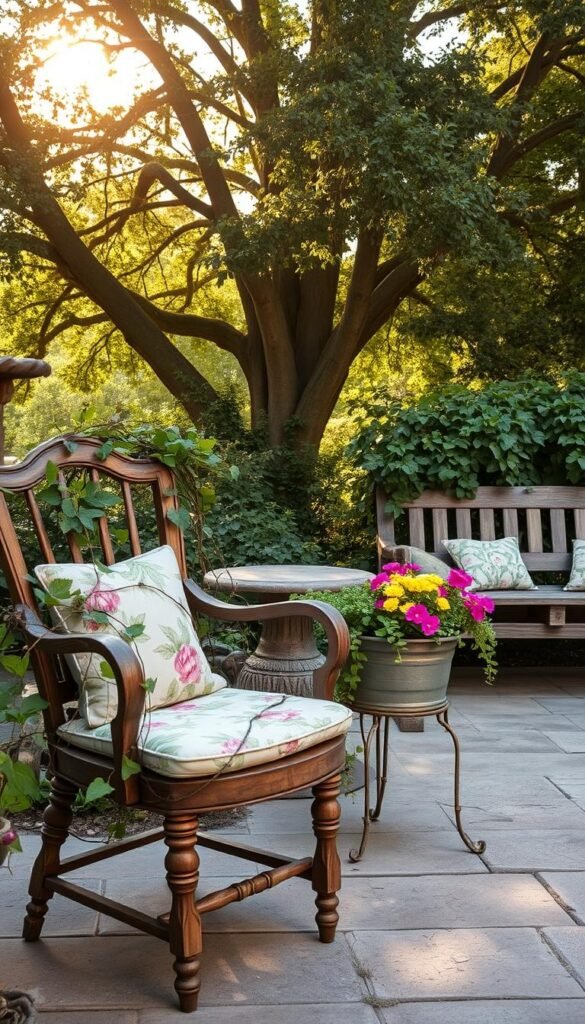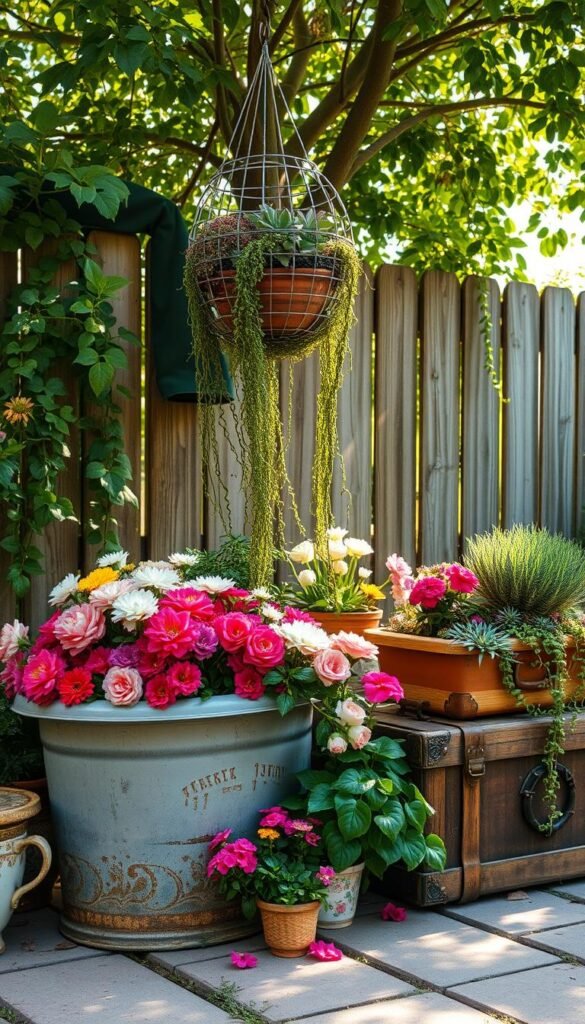Imagine turning forgotten treasures into eye-catching displays that make your yard truly one-of-a-kind. With a little creativity, everyday objects can become stunning homes for blossoms, adding personality to your outdoor areas while keeping materials out of landfills.
Thrift stores and neighborhood clean-up days often hide perfect candidates for repurposing. An old teapot becomes a charming herb planter. Chipped ceramics transform into cascading succulent arrangements. The secret? See beyond an item’s original purpose and visualize how it could showcase greenery or blooms.
This approach isn’t just about aesthetics – it’s practical too. By giving discarded items new roles, you save money on traditional pots and reduce waste. Many enthusiasts report spending under $10 on materials for showstopping pieces that become conversation starters.
We’ll show you how to spot potential in unexpected places, from vintage kitchenware to construction leftovers. You’ll learn to assess items for durability, create proper drainage systems, and protect your creations from the elements. Whether you’re working with a sprawling backyard or a cozy balcony, these techniques help craft spaces that feel uniquely yours.
Finding Inspiration in Unique Upcycled Garden Treasures

Every discarded item holds a story waiting to bloom in your outdoor space. The thrill lies in spotting potential where others see clutter – a cracked teacup becomes a fairy garden centerpiece, while weathered toolboxes morph into rustic herb homes.
Exploring Estate Sales and Curbside Finds
Friday estate sale adventures offer more than nostalgia – they’re goldmines for patient seekers. Final-day discounts often reveal vintage spreaders or wheelbarrows perfect for floral displays. One couple’s “Curb to Cottage” ritual rescued a chipped birdbath now overflowing with pansies.
Curbside treasures require quick thinking. Keep gloves in your car for spontaneous rescues. That “broken” chair? Remove the seat, add potting mix, and watch trailing petunias cascade through the slats.
Embracing Vintage and Thrifted Gems
Thrift stores surprise with character-rich pieces – enamelware bowls with hairline cracks make ideal succulent planters. At ReStore locations, ask clerks about incomplete items: “Could this drawer become a vertical herb garden?” Sharing your vision often leads to better prices and sparks creative family projects.
Look for rust patterns that create natural texture. A 1950s breadbox missing its door? Line it with moss for a living wall art piece. The secret? See beyond dust and dents to imagine vibrant blossoms softening edges of time.
DIY Flower Garden Projects: Upcycled Containers, Paths, and More

Your kitchen junk drawer might hold the secret to your next stunning floral display. Those empty coffee tins and yogurt cups collecting dust? They’re about to become your favorite planter solutions. With simple modifications, you can turn household castoffs into thriving homes for flowers and herbs.
Transforming Common Items into Charming Planters
Tin cans shine as versatile pots – punch drainage holes with a nail, then paint them vibrant colors. Cluster three sizes together for a cascading effect. Glass candle jars become elegant terrariums when filled with soil and delicate succulents. “The best planters often come from unexpected places,” notes urban gardener Lila Chen. “My basil thrives in repurposed takeout containers!”
| Container | Best For | Prep Tip |
|---|---|---|
| Egg cartons | Seed starters | Add compost to each cup |
| Plastic bottles | Vertical gardens | Cut side openings |
| Light bulbs | Air plants | Remove metal base |
| Wooden pallets | Living walls | Line with fabric |
Designing Whimsical Garden Paths
Turn broken ceramics into mosaic stepping stones. Bury wine bottles neck-down to create glowing borders along walkways. For a playful touch, alternate reclaimed bricks with slices of tree stumps. These garden projects add personality while keeping materials from landfills.
Discover more budget-friendly container ideas that make your space bloom. Remember: good drainage prevents soggy roots. Always drill holes in sealed containers before adding soil and plants.
Transforming Everyday Items into Garden Art
Your garage might hold hidden gems waiting to become striking garden features. Rusty tools and outdated appliances gain new life when paired with vibrant plants, creating eye-catching displays that blur the line between functional and artistic.
Breathing New Life Into Forgotten Tools
Vintage toolboxes with chipped paint work wonders as planters. Their natural patina adds character to home gardens – try filling one with red geraniums for July Fourth flair. Rolling tool carts become mobile flower stands, letting you rearrange your outdoor art as seasons change.
| Item | Use Case | Design Tip |
|---|---|---|
| Metal toolbox | Patriotic floral displays | Line with moss for moisture |
| Tool caddy | Herb garden storage | Label compartments |
| Retired lamp | Hanging planter base | Remove wiring first |
| Baking sheets | Succulent arrangements | Drill drainage holes |
Strategic Floral Pairings That Last
Mix real and artificial blooms to maintain color year-round. Faux peonies thrive in shaded areas where real plants struggle. Try pairing weathered shovels with silk sunflowers – the contrast between rough metal and delicate petals creates instant garden drama.
During winter, swap live flowers for frost-resistant artificial ones in your toolbox planters. This keeps your outdoor art vibrant even when temperatures drop. For indoor displays, combine dried eucalyptus with faux roses in a repurposed watering can.
Innovative Container Ideas for Lively Garden Displays

Vintage farm finds bring rustic elegance to modern spaces. Those sturdy milk cans gathering dust at flea markets? They’re ready to shine as unique planters that blend history with horticulture.
Using Vintage Tools, Milk Cans, and Bottles
Milk cans flanking entryways create instant charm. Their narrow openings perfectly cradle potted blooms – just slip in a plastic nursery container for easy swaps. Pair them with clearance flowers from local markets for budget-friendly bursts of color.
Clear glass milk bottles double as tabletop masterpieces. Arrange single stems in individual bottles for a coordinated look, or mix heights for visual interest. Pro tip: Use broken faux stems creatively by trimming them to fit smaller openings.
| Item | Best Use | Design Hack |
|---|---|---|
| Milk can | Pathway markers | Elevate pots with bricks inside |
| Milk bottle | Dining centerpiece | Add food coloring to water |
| Vintage spreader | Herb display | Use built-in drainage holes |
Preserve delicate antiques by keeping soil in removable containers. This approach lets you rotate planters seasonally while protecting weathered surfaces. For wheelbarrows, line the bed with landscape fabric before adding potting mix to prevent rust.
Turning Old Furniture and Decor Into Garden Features

What do an old kitchen chair and a rusty tricycle have in common? Both can become showstopping additions to your outdoor space. With simple modifications, these forgotten items breathe new life into your landscape while adding personality.
Upcycling Kitchen Chairs, Mailboxes, and Wagons
Give mismatched chairs fresh purpose by converting them into elevated flower planters. Remove seats and line the frame with chicken wire. Add coir matting to hold potting mix. A coat of white paint creates cottage charm, while trailing petunias soften weathered edges.
Vintage mailboxes shine as seasonal displays. Their built-in openings become perfect nests for pansies or marigolds. Paint them sky-blue for spring tulips or crimson for autumn mums. Rotate blooms quarterly to match holidays or migrating bird activity.
Creative Uses for Bicycles and Tricycles
Mount wire baskets on bicycle handlebars for mobile flower planters that sway with summer breezes. Secure enamel bowls to tricycle seats using weatherproof zip ties. These playful displays add movement to static garden spaces.
Children’s trikes from garage sales offer sturdy bases for larger arrangements. Their wide frames support multiple containers – try pairing herbs with cascading lobelia. Anchor planters securely while preserving the vehicle’s whimsical appeal.
For outdoor living areas, position repurposed items near seating zones. A wagon-turned-planter beside patio chairs creates visual height variation. Always drill drainage holes in sealed containers to protect plant roots.
Creative Techniques for Ensuring Proper Drainage and Durability

Water management separates thriving planters from swampy disasters. Your upcycled treasures need smart solutions to balance moisture control with structural preservation.
Drilling and Layering Methods for Longevity
Choose your strategy based on container value. For sentimental pieces, use removable pots inside decorative items. This protects delicate surfaces while letting you adjust soil depth. Need permanent planting? Try these approaches:
- Rock reservoirs: Fill 25% of containers with gravel or broken bricks
- Layered defense: Alternate coconut coir with activated charcoal
- Smart tipping: Angle wheelbarrows after storms to shed water
Diamond-tipped drills conquer most ceramics, but test inconspicuous areas first. “My grandmother’s soup tureen needed three attempts before holding succulents,” shares urban gardener Marco Torres. For 5-gallon bucket gardening, drill 5-7 holes in the base for optimal flow.
| Material | Best Drainage Method | Protection Tip |
|---|---|---|
| Rust-prone metal | Inner plastic liner | Elevate with wooden blocks |
| Delicate ceramics | Pebble base layer | Use saucers underneath |
| Wooden containers | Landscape fabric | Apply waterproof sealant |
Remember: Proper drainage keeps roots healthy and prevents container decay. Mix potting soil with perlite for better aeration, especially in non-drilled planters. Your vintage finds will thank you with years of lush growth.
Harnessing the Charm of Upcycled Garden Lighting
Twinkle lights aren’t the only way to brighten your outdoor space. Discarded lighting fixtures hold untapped potential as garden art that combines function with creative flair. With simple modifications, these pieces become glowing focal points that elevate your decor after sunset.
Modernizing Old Lamps and Chandeliers
Transform table lamps into sculptural accents by removing cords and bulbs. A coat of weather-resistant paint in bold hues like tangerine or teal gives new personality. Attach small watering cans to lamp bases using colorful ribbons – perfect for trailing ivy or petunias.
Salvaged chandeliers shine as hanging planters. Remove electrical components from thrifted finds, then suspend them from tree branches. Insert floral tubes into crystal arms to display fresh-cut blooms. One gardener’s $10 ReStore find now showcases rotating seasonal flowers above her patio table.
Crafting Ambient Outdoor Displays
Cluster candleholders of varying heights on side tables for mood lighting. Fill glass shades with sand and battery-operated fairy lights for windproof glow. Metal wall sconces missing their shades? They become ideal mounts for shallow-rooted succulents when lined with moss.
These lighting conversions prove that garden style doesn’t require expensive fixtures. With imagination, even broken lamps earn a top spot in your outdoor oasis. The best part? Each piece tells its own story through reinvented purpose.






